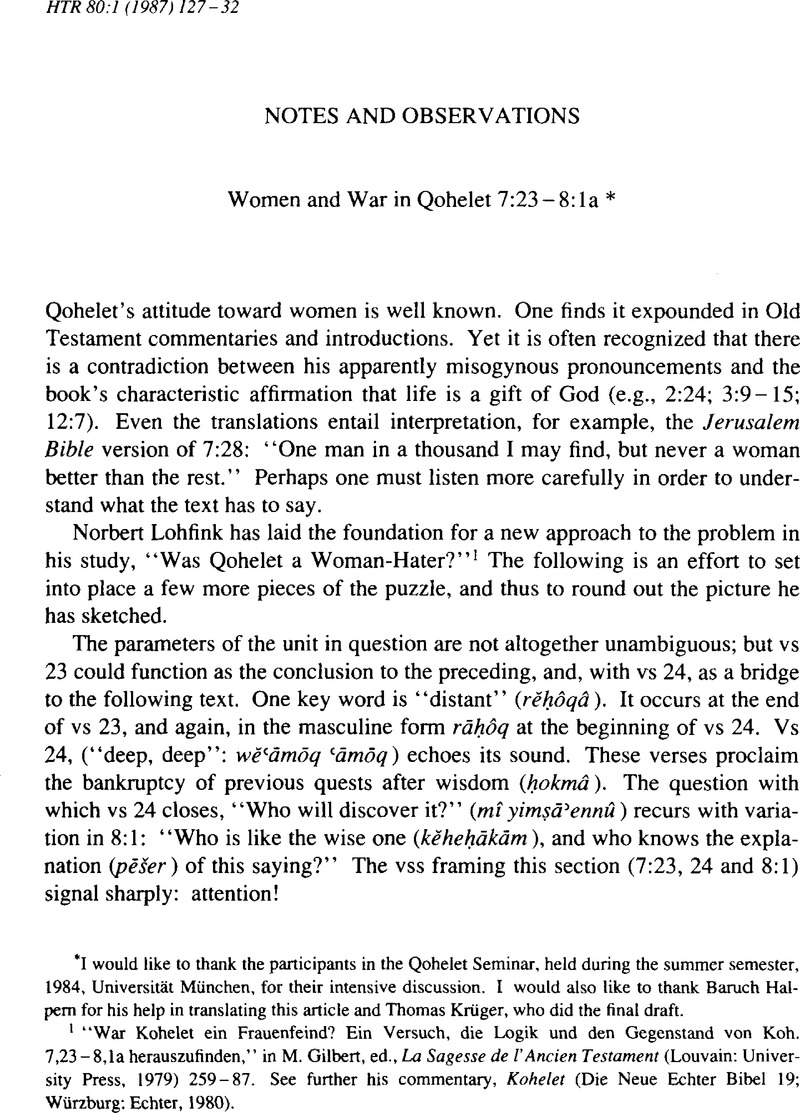No CrossRef data available.

1 “War Kohelet ein Frauenfeind? Ein Versuch, die Logik und den Gegenstand von Koh. 7, 23–8, laherauszufinden,” in Gilbert, M., ed., La Sagesse de l'Ancien Testament (Louvain: University Press, 1979) 259–87.Google Scholar See further his commentary, Kohelet (Die Neue Echter Bibel 19; Würzburg: Echter, 1980).Google Scholar
2 See Seybold, Klaus, “ḥāšab,” ThWAT 3 (1982) 243–61.Google Scholar
3 Lohfink (“War Kohelet,” 281–82) believes one should render mar here “stronger than death.”
4 Ibid., 279 (“Sprachschatz einer geschlossenen Männerkultur”).
5 On 7:26b see Ibid. (“So reden Männer, wenn sie unter sich sind, etwa wenn erzählt wird, dass einer aus dem Kreis bald heiraten wird. Man zitiert so etwas dann und lacht darüber. Der Tiefenpsychologe mag analysieren, was sich dabei abspielt.”)
6 Ibid., 285.
7 Cf. the omission in Cant 4:5a–7, according to Horst, Friedrich, “Die Formen des althebräischen Liebesliedes,” in Paret, Rudi, ed., Orientalistische Studien: Enno Littmann zu seinem 60. Geburtstag am 16. September 1935: überreicht von Schülern aus seiner Bonner und Tübinger Zeit (Leiden: Brill, 1935) 43–54Google Scholar; reprinted in Gottes Recht: Gesammelte Studien zum Recht im Alten Testament (München: Kaiser, 1961) 176–87, esp. 180 n. 7.Google Scholar
8 In terms of genre, the text in vs 26a is to be compared to the love songs. Horst calls the particular type the Beschreibungslied (“song of description”). He compares this song to the Arabic Waṡf: “Die Beschreibungslieder haben zum Inhalt eine in bestimmter Reihenfolge verlaufende, mehr oder weniger detaillierte Schilderung aller körperlichen Vorzüge der Geliebten” (“Formen,” 180). As a case in the Old Testament, Horst compares Cant 4:1–5; 5:10–16; 7:1–6. The form is certainly ancient. An Egyptian example is preserved in Papyrus Harris 500. The text is of interest in that it applies the motif of the “bird trap” in a positive sense:
In view of the variety of levels inherent in Qohelet's discussion, it is appropriate further to compare the riddle as a literary form in antiquity. From the Old Testament, Judges 14 is of special interest. Cf. Eissfeldt, Otto, Einleitung in das Alte Testament (3d ed.; Tübingen: Mohr-Siebeck, 1964) 113–15Google Scholar; Schultz, W., “Rätsel,” PW (2d series; Stuttgart: Druckenmüller, 1914) 1. 62–125Google Scholar, for a treatment containing much material, but even more problems.
9 It is striking that at just this point the Massoretic Text treats Qohelet as feminine: “says (fem.) the preacher (fem.)” (ʾāmrâ qohetet). Is this intentional or accidental? Textual disturbance is a possibility, but the received text is certainly the lectio difficilior, a “she” instructs the men!
10 Lohfink, “War Kohelet,” 280–81.
11 See, e.g., Lauha, Aarre, Kohelet (BKAT 19; Neukirchen: Neukirchener Verlag, 1978) 140Google Scholar: “Schon die Feststellung in V. 28, dass Kohelet unter tausend Menschen keine (gute) Frau gefunden habe, zeigt, dass es sich nicht um private Eheerfahrungen handelt, sondern um eine prinzipielle Wertschätzung.” See also 142–45.
12 Lohfink, “WarKohelet,” 281.
13 Ibid.
14 See KB on ʾelep III. Cf. Num 10:4; 31:5; Judg 6:15; Mendenhall, George E., “The Census Lists of Numbers 1 and 26,” JBL 77 (1958) 52–66.Google Scholar
15 See Seybold, “ḥāšab,” 254: “Wie ein Kommentar zu Gen 6:5; 8:21 liest sich Pred 7:29.”
16 Ibid., 251–52: “‘Constructions—the invention of an engineer (i.e., a marvel of engineering) relating to machines to fire arrows, and catapults, for the defense of a city, for which no special term was yet known,” citing Welten, Peter, Geschichte und Geschichtsdarstellung in den Chronikbüchern (WMANT 42; Neukirchen: Neukirchener Verlag, 1973) 111ff.Google Scholar
17 On the same theme, cf. Aristophanes Lysistrata (performed 411 BCE).